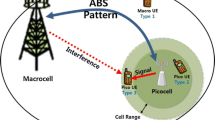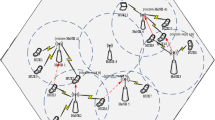Abstract
Recently, femtocells (HeNBs) are deployed in heterogeneous network (HetNets) attributable to the addition of coverage, capacity and impeccable spectrum efficiency in private buildings/office complexes surroundings. This unplanned placement of HeNBs creates co-channel interference (CCI) in orthogonal frequency division multiple access (OFDMA). As a result service, disruption occurred at the macrocell user and femtocell user. Therefore, with always expanding interest for frequency spectrum, there is have to make available more resource allocation in order to permit more quantities of unlicensed clients to transmit their signals in the authorized groups. Cognitive-based approaches may increase the spectrum efficiency by sharing resources opportunistically from unlicensed/licensed network. However, spectrum management processes quite difficult, and a lot of chance to occur interference at the cell-edge users. Therefore, a dynamic spectrum allocation scheme is proposed for OFDMA based HetNets. The proposed scheme efficiently reduces the interferences through subchannel detection. To accomplish the CCI mitigation, the proposed scheme is functioning using the energy exposure with group creation algorithm for subchannel detection. Finally, the detected subchannel is allocated through applying power allocation algorithm. The simulation results represent that proposed scheme is able to maximize the spectrum detection and enhanced the spectral efficiency. The improved spectral efficiency recuperates the CCI situation at underlay HetNets.









Similar content being viewed by others
References
Peng, M., & Wang, W. (2009). Technologies and standards for TD-SCDMA evolutions to IMT-advanced. IEEE Communication Magazine, 47(12), 50–58. doi:10.1109/MCOM.2009.5350368.
Cheung, W., Quek, T., & Kountouris, M. (2012). Throughput optimization, spectrum allocation, and access control in two-tier femtocell networks. IEEE Journal on Selected Area Communications, 30(4), 561–574. doi:10.1109/JSAC.2012.120406.
Hasan, M. K., Ismail, A. F., Islam, S., & Hashim, W. (2016). Self-organized HGBBDSA approach for the power allocation in OFDMA-based heterogeneous network. International Journal of Hybrid Information Technology, 9(7), 419–428. doi:10.14257/ijhit.2016.9.7.38.
GPP, Tech. Spec. Group, E-UTRAN. (2011). Self-configuring and self-optimizing network (SON) use cases and solutions. Rel. 9. 3GPP-TR36.902V9.3.1. www.3gpp.org/ftp/specs/archive/36_series/36.902. Accessed August 29, 2016.
Hasan, M. K., Ismail, A. F., Aisha, H. A., Abdullah, K., Ramli, H., Islam, S., et al. (2013). Inter-cell interference coordination in heterogeneous Network: A qualitative and quantitative analysis. In IEEE Malaysia international conference on communications (MICC’13), 26–28 November, 2013. doi:10.1109/MICC.2013.6805855.
Hasan, M. K., Ismail, A. F., Abdalla, A. H., Abdullah, K., Ramli, H., Islam, S., et al. (2013, August). Inter-cell interference coordination in LTE-A HetNets: A survey on self organizing approaches. In 2013 International conference on computing, electrical and electronics engineering (ICCEEE) (pp. 196–201). IEEE.
Peng, M., Liang, D., Wei, Y., Li, J., & Chen, H. H. (2013). Self-configuration and self-optimization in LTE-advanced heterogeneous networks. IEEE Communications Magazine, 51(5), 36–45. doi:10.1109/MCOM.2013.6515045.
de Lima, C. H., Bennis, M., Ghaboosi, K., & Latva-aho, M. (2010, September). Interference management for self-organized femtocells towards green networks. In 2010 IEEE 21st international symposium on personal, indoor and mobile radio communications workshops (PIMRC Workshops) (pp. 352–356). IEEE. doi:10.1109/PIMRCW.2010.5670393.
Chowdhury, M. Z., Jang, Y. M., & Haas, Z. J. (2010, June). Interference mitigation using dynamic frequency re-use for dense femtocell network architectures. In 2010 second international conference on ubiquitous and future networks (ICUFN) (pp. 256–261). IEEE. doi:10.1109/ICUFN.2010.5547193.
Oh, D.-C., & Lee, Y.-H. (2012). Cognitive radio based resource allocation in femto-cells. Journal of Communications and Networks, 14(3), 252–256.
Zhang, H., Chen, S., Li, X., Ji, H., & Du, X. (2015). Interference management for heterogeneous networks with spectral efficiency improvement. Wireless Communications, IEEE, 22(2), 101–107.
Lei, W., Hai, W., Yinghui, Y., & Fei, Z. (2010, November). Heterogeneous network in LTE-advanced system. In 2010 IEEE international conference on communication systems (ICCS) (pp. 156–160). IEEE.
Saquib, N., Hossain, E., Le, L. B., & Kim, D. I. (2012). Interference management in OFDMA femtocell networks: issues and approaches. IEEE Wireless Communications, 19(3), 86–95.
Chowdhury, M. Z., Jang, Y. M., & Haas, Z. J. (2011). Cost-effective frequency planning for capacity enhancement of femtocellular networks. Wireless Personal Communications, 60(1), 83–104.
Cheng, S. M., Ao, W. C., Tseng, F. M., & Chen, K. C. (2012). Design and analysis of downlink spectrum sharing in two-tier cognitive femto networks. IEEE Transactions on Vehicular Technology, 61(5), 2194–2207.
Yun, J. H., & Shin, K. G. (2011). Adaptive interference management of OFDMA femtocells for co-channel deployment. IEEE Journal on Selected Areas in Communications, 29(6), 1225–1241.
Ali, S. H., & Leung, V. C. (2009). Dynamic frequency allocation in fractional frequency reused OFDMA networks. IEEE Transactions on Wireless Communications, 8(8), 4286–4295.
Zhang, Y., & Leung, C. (2009). Resource allocation in an OFDM-based cognitive radio system. IEEE Transactions on Communications, 57(7), 1928–1931. doi:10.1109/TCOMM.2009.07.070157.
Hasan, M. K., Ismail, A. F., Abdalla, A.-H., Hashim, W., & Islam, S. (2015). Throughput evaluation for the downlink scenario of co-tier interference in heterogeneous network. ARPN Journal of Engineering and Applied Sciences, 10(21), 9664–9668.
Zeng, L., & McGrath, S. (2012, September). Joint spectrum sensing and power allocation algorithm for spectrum efficiency optimization in ultra wideband cognitive radio networks. In 2012 IEEE vehicular technology conference (VTC Fall) (pp. 1–5). IEEE.
Hasan, M. K., Ismail, A. F., Abdalla, A. H., Ramli, H. A. M., Islam, S., Hashim, W., et al. (2015). Cluster-based spectrum sensing scheme in heterogeneous network. In H. A. Sulaiman, M. A. Othman, M. Z. A. Abd. Aziz & M. F. Abd Malek (Eds.), Theory and applications of applied electromagnetics: APPEIC 2014 (pp. 1–11). New York: Springer.
Hasan, M. K., Ismail, A. F., Abdalla, A. H., Ramli, H. M., Islam, S., & Hashim, W. (2014, September). Performance analysis of spectrum sensing methods: A numerical approach. In 2014 International conference on computer and communication engineering (ICCCE) (pp. 193–196). IEEE.
Luo, J., Wang, J., Li, Q., Wu, C., & Li, S. (2013, September). Normalized energy detection based cooperative spectrum sensing with reporting errors in heterogeneous cognitive radio networks. In 2013 IEEE 24th annual international symposium on personal, indoor, and mobile radio communications (PIMRC) (pp. 745–749). IEEE.
Scharf, L. L. (1991). Statistical signal processing (Vol. 98). Reading, MA: Addison-Wesley.
Rahman, M. A., Song, C., & Harada, H.. Development of a TV white space cognitive radio prototype and its spectrum sensing performance. In 2011 sixth international ICST conference on cognitive radio oriented wireless networks and communications (CROWNCOM). 2011. IEEE.
Jin, F., Zhang, R., & Hanzo, L. (2013). Fractional frequency reuse aided twin-layer femtocell networks: Analysis, design and optimization. IEEE Transactions on Communications, 61(5), 2074–2085.
Acknowledgements
This research has been sponsored by the government of Malaysia, through Ministry of Education. So, an especial acknowledgment to the government of Malaysia and thanks to Research Management Center (RMC), International Islamic University Malaysia.
Author information
Authors and Affiliations
Corresponding author
Rights and permissions
About this article
Cite this article
Hasan, M.K., Ismail, A.F., Islam, S. et al. Dynamic Spectrum Allocation Scheme for Heterogeneous Network. Wireless Pers Commun 95, 299–315 (2017). https://doi.org/10.1007/s11277-016-3893-5
Published:
Issue Date:
DOI: https://doi.org/10.1007/s11277-016-3893-5




